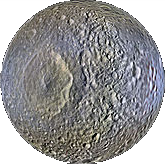Please cite reliable and peer reviewed sources, that are not your brain. Unsourced material may be removed or deleted.
Mimas, also known as Saturn VI, is a natural satellite of the outer planet, Saturn. The moon was discovered on September 17, 1789 by the British astronomer William Herschel. Mimas is the smallest astronomical body known to be in hydrostatic equilibrium. The moon's presence has created one of the largest 'gaps' in Saturn's ring, named the Cassini Division, due to orbital resonance destabilizing the particles' orbit there.
Surface Features
The surface of Mimas was examined several times by orbiters. The moon has an extremely rocky surface, showered with craters. It has a giant crater known as Herschel, which gives it the appearance of the Death Star from Star Wars.
| Geology of Mimas | |
|---|---|
| Craters | Accolon • Arthur • Balin • Ban • Bedivere • Bors • Dagonet • Dynas • Elaine • Gaheris • Galahad • Gareth • Gawain • Gwynevere • Herschel • Igraine • Iseult • Kay • Lamerok • Launcelot • Lot • Lucas • Marhaus • Mark • Melyodas • Merlin • Modred • Morgan • Nero • Palomides • Pellinore • Percivale • Royns • Tristram • Uther |
| Chasms | Avalon • Camelot • Oeta • Ossa • Pangea • Pelion |
| Crater Chains | Tintagil Catena |
Composition
Mimas's low density, 1.15 g/cm3, indicates that it is composed mostly of water ice with only a small amount of rock.
Gallery
| Moons of Saturn | |
|---|---|
| Ring Shepherds | S/2009 S 1 • Pan • Daphnis • Atlas • Prometheus • Pandora |
| Co-orbitals | Janus • Epimetheus |
| G Ring | Aegaeon |
| Alkyonides | Methone • Pallene • Anthe |
| Inner Large Moons | Mimas • Enceladus • Tethys • (Telesto • Calypso) • Dione • (Helene • Polydeuces) |
| Outer Large Moons | Rhea • Titan • Hyperion • Iapetus |
| Inuit | Kiviuq • Paaliaq • Siarnaq • Ijiraq • S/2005 S 4 • S/2019 S 1 • S/2020 S 1 • Tarqeq • S/2004 S 31 • S/2019 S 14 • S/2020 S 3 • S/2019 S 6 |
| Gallic | Albiorix • Bebhionn • S/2007 S 8 • S/2004 S 29 • Erriapus • Tarvos • S/2020 S 4 |
| Norse | Phoebe • S/2006 S 20 • S/2006 S 9 • Skathi • S/2007 S 5 • S/2007 S 7 • S/2007 S 2 • S/2004 S 37 • S/2004 S 47 • S/2004 S 40 • S/2019 S 2 • S/2019 S 3 • S/2020 S 7 • Skoll • S/2020 S 2 • S/2019 S 4 • S/2004 S 41 • S/2004 S 42 • Hyrrokkin • Greip • S/2004 S 13 • S/2007 S 6 • Mundilfari • S/2006 S 1 • S/2004 S 43 • S/2006 S 10 • S/2019 S 5 • Gridr • Bergelmir • Jarnsaxa • Narvi • Suttungr • S/2007 S 3 • S/2004 S 44 • S/2004 S 45 • Hati • S/2004 S 17 • S/2006 S 11 • S/2004 S 12 • Eggther • S/2006 S 13 • S/2007 S 9 • S/2019 S 7 • S/2019 S 8 • Farbauti • Thrymr • Bestla • S/2019 S 9 • S/2004 S 46 • Angrboda • S/2019 S 11 • Aegir • Beli • S/2019 S 10 • S/2019 S 12 • Gerd • S/2019 S 13 • S/2006 S 14 • Gunnlod • S/2019 S 15 • S/2020 S 6 • S/2004 S 7 • S/2006 S 3 • S/2005 S 5 • Skrymir • S/2006 S 16 • S/2006 S 15 • S/2004 S 28 • S/2020 S 8 • Alvaldi • Kari • S/2004 S 48 • Geirrod • Fenrir • S/2004 S 50 • S/2006 S 17 • S/2004 S 49 • S/2019 S 17 • Surtur • S/2006 S 18 • Loge • Ymir • S/2019 S 19 • S/2004 S 21 • S/2019 S 18 • S/2004 S 39 • S/2019 S 16 • S/2004 S 53 • S/2004 S 36 • Thiazzi • S/2019 S 20 • S/2006 S 19 • S/2004 S 26 • Fornjot • S/2004 S 51 • S/2020 S 10 • S/2020 S 9 • S/2004 S 34 • S/2019 S 21 • S/2004 S 52
|
| Outlier Prograde Satellites | S/2006 S 12 • S/2004 S 24 |
| Spurious Moons | Chiron • Themis • S/2004 S 6 • S/2004 S 4 • S/2004 S 3 • Peggy |







